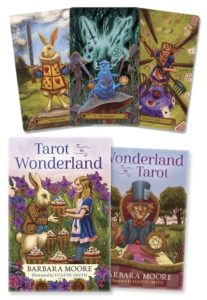The Hierophant in Wonderland

Have you ever heard a tarot teacher suggest throwing away the book that came with a deck? While I can see the benefits to approaching the cards with fresh eyes, I’d encourage just setting the book aside rather than tossing it out. Most books that come with a deck not only provide interesting deck specific information but also present basic tarot information in new ways.
We rarely showcase tarot companion book text, and it is time we changed that.
Tarot in Wonderland was created (with her visions brought to life by artist Eugene Smith) by someone who loves Alice in Wonderland and Through the Looking Glass. The images blend the characters and settings from the stories with the meanings of traditional tarot. The book features many quotes and describe the meanings of the cards in unique ways.
In the excerpt below, the Through the Looking Glass section explores the connections between the meaning and the stories. Down the Rabbit Hole is for those who want a quick interpretation when doing readings.

V, The Hierophant
Through the Looking Glass
These days, The Hierophant is one of the most disliked cards in tarot. That is because people have too narrow a view of The Hierophant because traditional imagery shows this character as a Roman Catholic Pope. The Pope is just manifestation of the spiritual, ethical, or philosophical teacher archetype, which is what this card really is. The Hierophant, regardless of the specific image used to illustrate this card, represents the underlying belief system that guides our behaviors and actions. Different versions of this archetype…a Catholic Pope, an evangelical pastor, a popular philosopher, a self-help guru, a motivational teacher…all share a similar quality: they suggest a possible way that the world works. Once you understand your own beliefs, then you can measure all your decisions, actions, words, and goals against that worldview. The Hierophant as a card doesn’t so much represent how to think as to the importance about what you think. What you accept as the “truth” about the world determines your behavior. When our behavior is at odds with our beliefs, we suffer severe emotional, spiritual, and psychological (and sometimes physical) distress.
The Cheshire Cat explains to Alice how Wonderland “works” and about the importance of knowing one’s goals. Some of the most famous lines (and there are so many) from the Alice stories are:
“But I don’t want to go among mad people,” Alice remarked.
“Oh, you ca’n’t help that,” said the Cat: “we’re all mad here. I’m mad. You’re mad.”
The Cheshire Cat gives an explanation that hinges on the idea that no one knows what is real and what is false. When his remarks are pushed further by philosophers and other great thinkers (as so much in the Alice stories has been), discussions include the inability to know for certain whether one is in a dream while one is in the dream. Likewise, when one is “mad” or what we would call suffering from mental illness is it possible to know that one is in a state of insanity? The idea of madness continues with the Mad Hatter and March Hare. I’ve heard that a basic definition of madness is when what is in our heads doesn’t match what is outside our heads, or what some call reality. To be in good mental, emotional, and spiritual health, our internal lives (our beliefs) must match our external lives (our actions).
Alice asks for directions but has no destination in mind. The Cat responds with “then it doesn’t matter which way you go.” This echoes wisdom from the Talmud that says “If you don’t know where you are going, any road will take you there.” If you have no goals, no intentions guiding your path, then what you do doesn’t matter. The Cat and the Talmud don’t mean goals like “make six figures” or “start a successful business,” at least not as ends in themselves. We are talking about core beliefs, about why we are here, and about what we believe we are meant to do.
Down the Rabbit Hole
In a reading, The Hierophant invites us to examine our actions and measure them against our beliefs. If they are lining up but things are still feeling wrong, then perhaps it is time to re-examine our guiding principles. If there is a gap between the ways in which we behave and what we claim to believe, then it is time to tighten up that space and start being the people that we aspire to be. When we are confused about which path to take or which way to go, we often turn to the cards for guidance. This card says that you need no outside advice but instead, but instead to do that which in your heart of heart you know to be the right thing.









